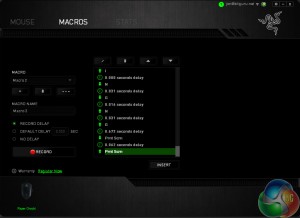Testing the Razer Orochi involved using it as my main office mouse for a period of just over a week, using it for web browsing and photo editing. It being a gaming mouse though, I also spent a lot of time testing it in FPS, RTS and slower paced puzzlers and point and clicks, all the while gauging its accuracy and speed, as well as its long term comfort.
It was also tested in both wired and wireless modes to see how they compare.
I start with the gaming, since that is the Orochi's big selling point. I found it a very capable right hand weapon. In wired mode it was fast and very accurate, and though it lacks the uber-high sensitivity and tracking of the Razer 5G sensor which it is putting in most of its high end mice, I still found the Orochi to be a very versatile gaming companion in all the titles I tested.
The lighting on the Orochi is quite subtle, which is a change of pace from some Razer mice
The fact that it is so lightweight too (without batteries), means that it does feel quick off of the mark. The slick cable means there never feels like there is much drag and the PTFE feet guarantee that you will not feel held up by anything. There is some tethering when using the cable, as it is very short (3.3ft) but considering this is a mouse aimed at laptop users, that makes sense.
When performing more office related tasks, I found the Orochi equally versatile. You are able to switch DPI with the right hand buttons by default – though can remap them if desired – which makes photo editing easier, as you can switch to a lower sensitivity for the more accuracy sensitive tools.
Switching over to wireless was not quite such smooth sailing unfortunately. Due to the Orochi utilising Bluetooth 4.0 as a connective platform if you do not have a laptop or desktop that supports that right off of the bat, you need to purchase an adapter. In some senses it is useful having a mouse that does not require a specific dongle – especially if you take it on the move – but having to get your own does leave you in the dark about the quality of adapter you are buying.
Options in the Synapse software are as fully featured as normal
Bluetooth also has a maximum polling rate of 125Hz, which when you are used to having a mouse at 500-1,000 Hz, does feel a little noticeable. I would not go so far as to call the Orochi a mouse that experiences lag, but it does not feel as responsive in wireless mode as it does when wired. It feels a little less accurate too, but that may be the same responsiveness issue being made apparent elsewhere.
In terms of the stats, Razer itself acknowledges that along with the polling rate difference, in wireless mode the Orochi operates with an 8ms response time, as opposed to 1ms when wired. This should not be noticeable except by super humans, so I wonder if a less-generic bluetooth adapter would have been preferable. In that case, I would like to see Razer offer a suggestion for those without native support.
Oddly enough, in games the difference was negligible. In fast paced MOBAs and FPS titles I had no issues whatsoever and did not perform any worse than I normally would. It was a little more apparent in office related tasks, but that seems to stem from the fact that switching from typing to mouse and keyboard usage required a period of adjustment to remember how the mouse operated with that micro-delay.
That was made more apparent by the Orochi turning itself off after a few seconds if not touched in order to save power. That setting can (and was) adjusted in the Razer Synapse software and it makes sense that it is there of course, but it was initially a minor annoyance.
There is no full Chroma support with this mouse. Macro recording went well but they occasionally did not stick.
Overall, the Razer Orochi does feel like a pretty capable wireless mouse, but it is difficult not to compare it with the wireless experience of Razer's stupendous wireless Mamba mouse which sets such a high bar. Although the Orochi is a lot cheaper, when you know Razer is capable of producing such a high-end wireless mouse, it is hard to settle for something that is not up to that standard.
The comfort of the Orochi over long periods was pretty good. It is not a particularly supportive mouse, due to its small stature, but it provides enough cushioning and grip points that all of the weight of your arm is not pressed into your wrist on the mat. It does suffer a little from perspiration build up during tense moments due to its hard plastic shell, but the rubber side grips mitigate any issues of slipping.
The Razer Synapse software was also a strong addition to the overall Razer Orochi package. However it did not perform quite as well as I have seen with other mice. A persistent issue it has had through a couple of versions is disconnecting my USB keyboard when updating – though unplugging and replugging tends to fix it.
Oddly too, the Orochi would lose any remapped or macro equipped switches when changed to wireless mode. We have reached out to Razer to find out why that was and will update this review when we hear back.
 KitGuru KitGuru.net – Tech News | Hardware News | Hardware Reviews | IOS | Mobile | Gaming | Graphics Cards
KitGuru KitGuru.net – Tech News | Hardware News | Hardware Reviews | IOS | Mobile | Gaming | Graphics Cards







